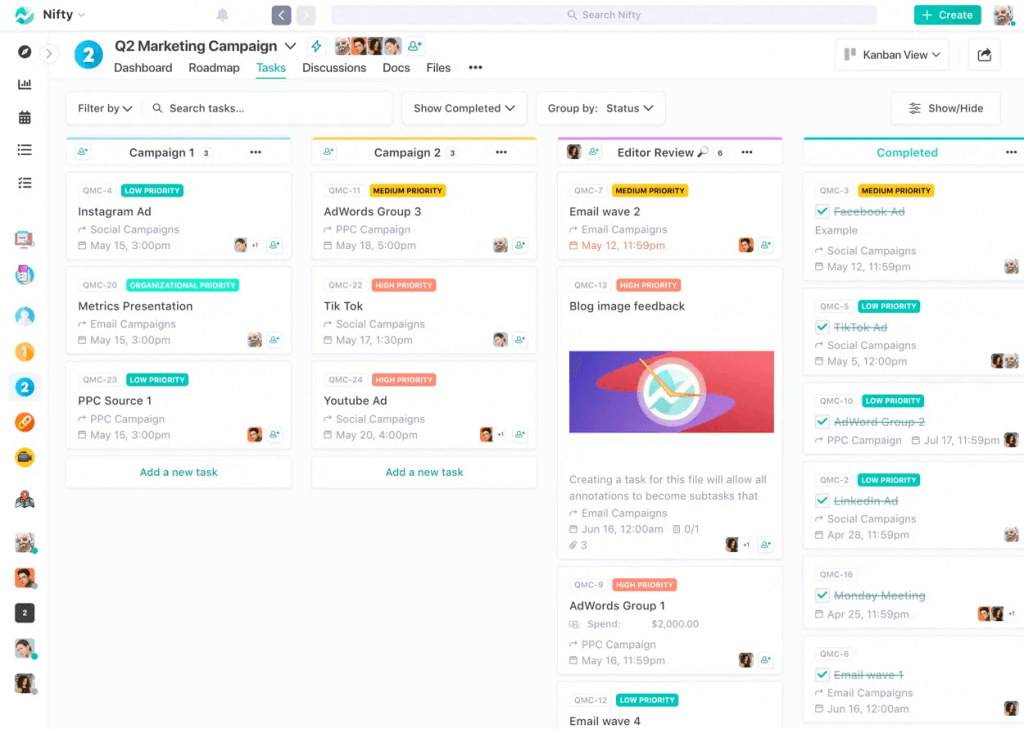
Like any manager, you’ll know that creating a remote team workflow can go a long way in determining the effectiveness of your team and the projects they take on.
If a remote team workflow is too lax and vaguely defined, projects will fall behind schedule, and success will be hard to measure. If it’s too strict and rigid, it can make workers inflexible and create rifts between teams and their managers.
Suppose you’re moving from a traditional project management system to creating remote team workflows. In that case, this will require a subtly different approach in order to maximize your chances of success.
6 Considerations When Creating a Remote Team Workflow
In today’s post, we’ll take a closer look at 6 of the most important considerations for when you’re creating remote team workflows.
1. Channels and Forms of Communication
One of the biggest challenges of remote management and working, in general, is ensuring that all communications are both timely and effective. Depending on the specifics of a particular project, workers may need immediate, dependable, and unified communications throughout their working hours.
Reliable communication will be a big part of what makes your workflow tick, establishing expectations as to what things should be discussed, where, and with whom. With this in mind, giving your communications plenty of thought in the early stages of developing your workflow is essential.
From occasional one-to-one check-ins to large team conferences and presentations, establishing expectations regarding internal comms will help keep everyone on the same page and avoid any confusions or errors that could mar the workflow’s efficacy.
2. Your Collaboration Tools
Modern teams can live or die on the strength of the tools they’re using, and this is especially true of remote teams who don’t have the opportunity to get together and plan out tasks face-to-face.
Comprehensive project management tools like our very own Nifty can supercharge the efficiency of your remote team workflow, allowing multiple users to stay updated on the progress of projects, share files, send messages, and much, much more.
The project management tool industry has exploded since the start of the COVID-19 pandemic, and there are countless options better suited to various industries, goals, and other nuances.

Whichever one you choose, the most important thing is to ensure every team member is comfortable with the established purposes of the tool and how to use the various views and features for the best possible results. Plan your training and access permissions as early as possible, and you’ll ensure that your team has everything they need to hit the ground running and avoid the common stumbling blocks of tech adoption.
3. Contingency Plans for Seasonal Fluctuation
Like in life, nothing is certain in business. Sudden, unexpected changes can crop up at short notice, and these situations will require a certain amount of flexibility in your remote team workflows to maintain their efficacy.
Even businesses that aren’t traditionally thought of as “seasonal” can be subject to rapid shifts in their usual activities, and many fail to rise to the challenge. Sales software provider Sopro documented in their recent Summer Slump report that “42% of businesses do nothing and 31% reduce sales and marketing activity” when faced with a seasonal downturn.
Though you can’t predict the future, establishing contingency plans for these fluctuations will bolster the long-term effectiveness of your remote team workflows and reduce the risk of unexpected issues causing your established ways of working on falling apart.
For example, if there’s a possibility for sudden slumps, try to equip yourself with training and development workflows with clear-cut responsibilities and schedules that can be initiated as soon as you need them. If you’re predicting a sudden uptick in demand, then make sure you’ll know who will be in charge of any outsourcing and reshuffling that may be required well ahead of time.
With various backup plans in place, any sudden surges or dips in business activity will allow you to adapt quickly and avoid disruptions and delays that can undermine your workflow.
4. Reliable Feedback Channels
Setting out a system for sharing feedback will empower your team with constant improvement and help to optimize their long-term efficiency. This 2022 survey from job board Zippia shows that “43% of highly engaged employees receive feedback at least once a week” and that more than half of surveyed workers feel like they’re not getting enough feedback.
With regular two-way communication between team members and managers or amongst peers, you can reinforce expectations and target issues as soon as they arise, making it easier for your team to schedule their work to allow time for revisions and changes in habits.
Aside from this, establishing a feedback system will not only help you improve your agile meetings, but it will also help you circumvent chaotic and counterproductive meetings where opinions and input are coming in from all angles and restrict these discussions to a purpose-built forum where feedback can be collated and actioned.
To make this easier, plenty of purpose-built HR tools, such as Leapsome, can help you facilitate peer feedback and customize employee development through a central and user-friendly platform.

Find one that suits your unique needs, and you’ll quickly be on your way toward a remote team workflow that streamlines regular tasks and keeps your team’s performance on a constant upward trajectory!
5. Testing and Tweaking
Like many things in business, one of the best ways to ensure the efficacy of your remote team is to constantly observe how various elements in your workflow are being received, test your processes, and make informed tweaks to established ways of working.
Additionally, consider implementing security measures such as a VPN or antivirus to safeguard sensitive information and facilitate secure communication. This approach can help you secure little wins and achieve all-around greater efficiency for your remote team.
This can take some trial and error, as different people will take to remote working in different ways. For example, some team members might thrive with each task broken down into smaller, clearly-outlined subtasks. In contrast, others will perform better when they’re given some basic task parameters and left to organize their approach as they see fit.
This is just one kind of nuance you’ll have to deal with if you want your remote team’s workflow to be as well-received and efficient as possible. Balancing established best practices with flexible management in a way that works for everyone can be challenging, but with incremental changes and regular analysis, finding a good middle ground can be a godsend for your remote team’s workflow.
6. Professional Boundaries and Socializing
Though it can be easy to overlook, setting clear professional boundaries and allowing room for socializing at work is immensely important for maintaining a happy, cohesive, and efficient team. This becomes even more true when you’re setting out a remote workflow, as socialization doesn’t happen as naturally compared to a regular office job in which people occupy the same space and can talk throughout the day.
Many people new to remote working find it difficult to keep their work and home life separate, which places them at greater risk of burnout and diminished performance. Ensure you’re incorporating a clear availability schedule in your workflow and delegating so that your team doesn’t have to work unsociable hours outside occasional crunch times.
Taking a proactive approach to your team’s social lives at work is another important consideration when it comes to crafting effective remote workflows, especially among newly-established teams that may not be familiar with each other.
Simple steps like having a friendly chat with your team, team scheduling, regular informal meetings, and organizing out-of-hours remote socials can all be great ways to break the ice and encourage your team to take the reins with their own social initiatives.
Final Thoughts
Creating a remote workflow can be challenging, especially if you come from a more traditional managerial background. However, without a correct workflow for a Remote Team, your workers could be held back from fulfilling their potential and developing into an effective, efficient remote team.
As you navigate the challenges of managing a remote team, we hope these considerations help you take a well-structured approach and set your team up for long-term success!







